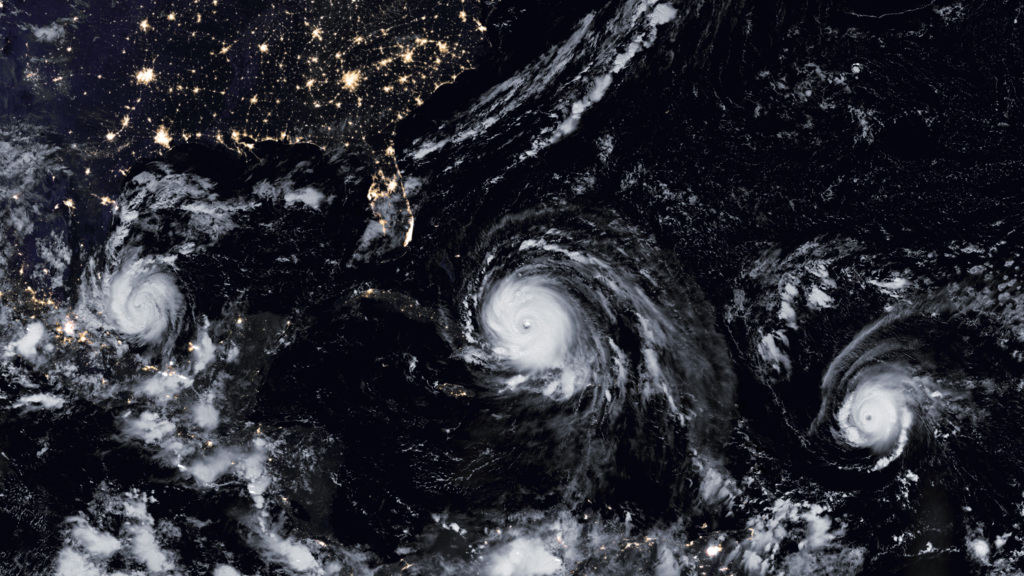GPM Examines Hurricane Irma
GPM scans Hurricane Irma on September 5th and again on September 7th as the storm approaches Puerto Rico, the Dominican Republic, and Haiti as a category 5 hurricane.
This video is also available on our YouTube channel.
The GPM core observatory satellite had an exceptional view of hurricane Irma's eye when it flew above it on September 5, 2017 at 12:52 PM AST (1652 UTC). This visualization shows a rainfall analysis that was derived from GPM's Microwave Imager (GMI) and Dual-Frequency Precipitation Radar (DPR) data. Irma was approaching the Leeward Islands with maximum sustained winds of about 178 mph (155 kts). This made Irma a dangerous category five hurricane on the Saffir-Simpson hurricane wind scale. Intense rainfall is shown within Irma's nearly circular eye.
This 3-D cross-section through Irma's eye was constructed using GPM's radar (DPR Ku band) data. GPM's radar revealed that the heavy precipitation rotating around the eye was reaching altitudes greater than 7.75 miles (12.5 km). The tallest thunderstorms were found by GPM's radar in a feeder band that was located to the southwest of Irma's eye. These extreme storms were reaching heights of over 10.0 miles (16.2 km). Intense downpours in the eye wall were found to be returning radar reflectivity values of over 80dBZ to the GPM satellite.
Irma rapidly intensified on September 4-5 as it moved over very warm waters and into an environment will weak vertical wind shear (the change of winds with height). Irma maintained maximum winds of 185 mph for a day and a half, making it one of the longest-lived storms at this intensity. That intensity made it the strongest observed storm over the Atlantic Ocean (excluding the Gulf of Mexico and Caribbean). Irma’s rapid intensification was very similar to Hurricane Harvey's in the Gulf about 10 days earlier.
GPM scans Hurricane Irma on September 5th and again on September 7th as the storm approaches Puerto Rico, the Dominican Republic, and Haiti as a category 5 hurricane. This version has no dates.

Dates-only version corresponding the the visualization above.

Color bar for liquid precipitation rates (ie, rain rates). Shades of green represent low amounts of liquid precipitation, whereas shades of red represent high amounts of precipitation.

Color bar for frozen precipitation rates (ie, snow rates). Shades of cyan represent low amounts of frozen precipitation, whereas shades of purple represent high amounts of precipitation.

Print resolution still image of Hurricane Irma approaching Puerto Rico on September 5th, 2017

Print resolution still image of Hurricane Irma approaching Puerto Rico on September 5th, 2017.
A cutting plane slices through 3D precipitation data to expose the eye of storm.

Print resolution still image of Hurricane Irma off the coast of Haiti on September 7th, 2017.

Print resolution still image of Hurricane Irma off the coast of Haiti on September 7th, 2017.
Credits
Please give credit for this item to:
NASA's Scientific Visualization Studio
-
Visualizers
- Kel Elkins (USRA)
- Alex Kekesi (Global Science and Technology, Inc.)
- Horace Mitchell (NASA/GSFC)
-
Producer
- Ryan Fitzgibbons (USRA)
-
Scientists
- Gail Skofronick Jackson (NASA/GSFC)
- George Huffman (NASA/GSFC)
- Dalia B Kirschbaum (NASA/GSFC)
Release date
This page was originally published on Sunday, September 10, 2017.
This page was last updated on Wednesday, November 15, 2023 at 12:11 AM EST.
Missions
This visualization is related to the following missions:Series
This visualization can be found in the following series:Datasets used in this visualization
-
[GOES: IR4]
ID: 33 -
Rain Rates (Surface Precipitation) [GPM: GMI]
ID: 822Credit: Data provided by the joint NASA/JAXA GPM mission.
See all pages that use this dataset -
Volumetric Precipitation data (Ku) [GPM: DPR]
ID: 830Credit: Data provided by the joint NASA/JAXA GPM mission.
See all pages that use this dataset -
IMERG
ID: 863This dataset can be found at: http://pmm.nasa.gov/sites/default/files/document_files/IMERG_ATBD_V4.4.pdf
See all pages that use this dataset
Note: While we identify the data sets used in these visualizations, we do not store any further details, nor the data sets themselves on our site.

![Watch this video on the NASA Goddard YouTube channel.Complete transcript available.Music credits: 'Micro Currents' by Jean-Patrick Voindrot [SACEM], 'Sink Deep' by Andrew Michael Britton [PRS], David Stephen Goldsmith [PRS], Mikey Rowe [PRS] from Killer Tracks.](/vis/a010000/a012700/a012738/LARGE_MP4-12738_RapidIntensification_large.00084_print.jpg)